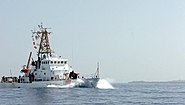| Island-class patrol boat | |
|---|---|
 | |
| Career (USCG) | |
| Builder: |
Bolinger Shipyard Lockport, Louisiana |
| General characteristics | |
| Class & type: | Island-class patrol boat (WPB) |
| Displacement: | 168 tons |
| Length: | 110 ft (34 m) |
| Beam: | 21 ft (6.4 m) |
| Draft: | 6.5 ft (2.0 m) |
| Propulsion: | 2 Paxman Valenta or Caterpillar diesels |
| Speed: | 29.5 knots |
| Range: | 3,300 miles |
| Endurance: | 5 days |
| Boats & landing craft carried: | 1 - Cutter Boat Medium (Yamaha 90 HP outboard engine) |
| Complement: | 16 (2 officers, 14 enlisted) |
| Sensors and processing systems: | AN/SPS-64V radar |
| Armament: |
Mk 38 25 mm chain gun 2 x M2 .50-cal MG |
| Aircraft carried: | None |
The Island-class patrol boat is a class of cutters of the United States Coast Guard. 49 cutters of the class were built, of which 41 remain in commission. Their hull numbers are WPB-1301 through WPB-1349.[1]
Island-Class Patrol Boat Overview[]
The 110' Island-class patrol boats are a U.S. Coast Guard modification of a highly successful British-designed patrol boat. With excellent range and seakeeping capabilities, the Island class, all named after U.S. islands, replaced the older 95-foot Cape-class cutters. These cutters are equipped with advanced electronics and navigation equipment and are used on the front lines of the Coast Guard's Maritime Homeland Security, Migrant Interdiction, Fisheries Enforcement, and Search-and-Rescue missions.
Conversion problems[]
As built, these vessels were all 110 feet (34 m) in length. In 2002 as part of the Integrated Deepwater System Program, the USCG began refitting these vessels, adding 13 feet (4.0 m) to the stern to make room for a high-speed stern launching ramp, and replacing the superstructure so that these vessels had enough room to accommodate mixed gender crews. The refit added about 15 tons to the vessel's displacement, and reduced its maximum speed by approximately one knot.
In 2005, then-Coast Guard Commandant Adm. Thomas H. Collins made the decision to stop the contractor's conversion at eight hulls when sea trials revealed intractable structural flaws.[2] [3]
In August 2006, a Lockheed Martin engineer went public with allegations that the company and the Coast Guard were ignoring serious security flaws in the refitting project, and that they were likely to repeat the same mistakes on similar projects. The flaws included blind spots in watch cameras, FLIR equipment not suitable for operating under extreme temperatures, and the use of non-shielded cables in secure communications systems, a violation of TEMPEST standards.[4]
In late November 2006 all eight of the 123' WPBs were taken out of service due to debilitating problems with their hulls. These as well as other issues - such as C4ISR problems - drove the program $60 million over budget, triple the original bid for the eight boats converted. The 41 unmodified 110's are now being pressed harder to take up the slack.[5]
See also[]
- USCG Marine Protector-class coastal patrol boat
- USCG Short Range Prosecutor
- USCG Cape-class cutter
- USCG Sentinel-class cutter
References[]
- ↑ "USCG: 110 ft Patrol Boat". http://uscg.mil/datasheet/110wpb.asp. Retrieved 1 March 2011.
- ↑ Nathaniel R. Helms (2005-06-23). "Coast Guard Scramble Over Deepwater Snag". Military.com. http://www.military.com/NewContent/0,13190,Defensewatch_062305_Helms,00.html. Retrieved 2009-10-08.
- ↑ "Coast Guard ends cutter conversion program". marinelog.com. 2005-07-18. http://www.marinelog.com/DOCS/NEWSMMV/2005jul0181.html. Retrieved 2009-10-08.
- ↑ Griff Witte (2006-08-29). "On YouTube, Charges of Security Flaws". Washington Post. http://www.washingtonpost.com/wp-dyn/content/article/2006/08/28/AR2006082801293.html. Retrieved 2009-10-08.
- ↑ Eric Lipton (2006-11-30). "Coast Guard to Idle 8 Cutters After $100 Million Renovation". The New York Times. http://www.nytimes.com/2006/11/30/washington/30ship.html. Retrieved 2009-10-08.
External links[]
- Video of the Matagorda deploying and retrieving her Short Range Prosecutor pursuit launch at speed.
- Official description of the conversion from 110 to 123 feet.
| ||||||||
The original article can be found at Island-class patrol boat and the edit history here.



